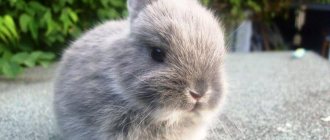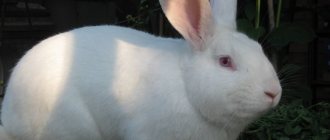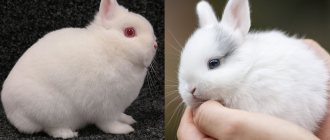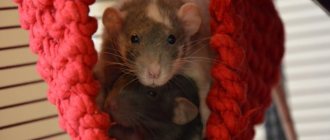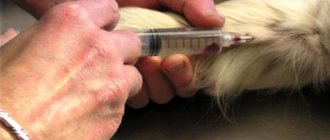74 comments October 2, 2013 Vladimir Khomyakov
Talk to me
It has been noticed that for the safest existence in the wild, rabbits, like all potential victims, extremely rarely use their vocal apparatus, and lead a secretive and silent lifestyle. But look how developed the ears are? With the help of such, so to speak, locators, rabbits quickly detect the source of danger and, as soon as possible, immediately hide in holes or other hidden places. For the farmer, this feature of the behavior of domestic rabbits is often beneficial and distinguishes our smaller brothers favorably from other brothers.
Silence almost always reigns in the rooms where these animals are kept. But the famous proverb says: “He who speaks less is listened to more.” What then to do with a rabbit who is almost always silent? It turns out there is nothing complicated here. If you want to understand a little and find out what our long-eared friend wants to tell us, this article is just for you.
When does a rabbit stop being silent and start screaming?
However, in rare cases, rabbits can still give their voice. In moments of extreme danger or severe pain, they emit a piercing scream or rather a squeal. They try to endure ordinary pain in silence. For wild rabbits, this innate quality often saves their lives, since enduring pain means preventing themselves from being detected by a predator. In households, on the contrary, it can play a cruel joke. Often a sick pet does not reveal itself in any way and thereby misleads inexperienced farmers. Only at the last moment does the rabbit suddenly begin to squeal loudly and immediately die in front of the owner’s eyes. But timely treatment could certainly correct the situation.
The loud screams of rabbits can also be heard during their martial arts. If, for example, a wild brother defends his right to a certain territory or two adult males were inadvertently placed in one cage, as well as during a planned replacement of a male during pit (aviary) keeping. At first, the animals seem to measure their strength, then the strongest begins to pursue the weaker. Sharp teeth turn out to be formidable weapons, the bites of which cause severe pain. Yes, and hitting with paws can lead to irreparable losses.
Grunting, ticking and other sounds.
In addition to loud and shrill sounds, rabbits can also “talk” in a quieter voice. This type of communication with their relatives and people resembles grunting. As a rule, you will hear such “speech” when animals approach each other or approach you. Rabbits often make exactly the same sound, only a little louder (ticking and cooing), during mating games. And by the characteristic relatively weak squeal of a male who has fallen on his side, an experienced rabbit breeder will immediately determine that he has conscientiously completed his mission of procreation.
Rabbits can also snort, thereby showing that they don’t like something. This is a kind of moderate act of aggression towards a potential offender. Most often these are people and pets (cats, dogs). Although silent themselves, rabbits nevertheless distinguish human voices very well. If the owner often communicates with the rabbit, talks to it, shows affection and friendliness, the rabbit quickly notices this, remembers it and begins to perceive you as its friend.
Brain inflammation
In order for the different systems of an animal’s body to function, the correct uninterrupted functioning of its brain is necessary. In this case, a living being reacts to a variety of external and internal factors, thinks, has different reflexes, etc. Also, if everything is in order with the brain, the rabbit moves quickly and clearly. If this organ is damaged, the consequences can be dire, and important functions are lost. If the rabbit breeder, together with veterinary specialists, fails to do anything, the animal dies.
If the pet's hind legs fail, this means there may be problems with the rabbit's brain; it may be inflamed. But such symptoms apply to several diseases.
With encephalitis, a sick rabbit does not stand up on its limbs, its head turns to the side. It is very difficult to cure an affected individual; even if in rare cases it works, a number of important impaired reflexes cannot be restored.
With encephalomyelitis, the brain is affected after an infectious disease. The animal's paws can be paralyzed. If you miss the moment when the first signs of the inflammatory process appear and do nothing, the rabbit can die within a day or four days.
With meningitis, both the brain and spinal cord become inflamed. The last resort is to kill the rabbit. But first you need to consult a veterinarian. Similar symptoms are observed with damage to the central nervous system, and it can be restored; specialized medications will be required; if you contact a specialized veterinary clinic at an early stage, the rabbit’s recovery is possible in a week.
As preventive measures to prevent paralysis of rabbit legs, you need to protect animals from falls, stress, communication with aggressive other pets at home or in the yard, consult a veterinarian once or twice a year, and give rabbits vitamin-mineral supplements or medications, for example, aminazine, monitor your diet and cell cleanliness.
The language of smells in the life of a rabbit.
Determines one's own - a stranger, a friend or an enemy.
Rabbits have a well-developed sense of smell. With its help, he distinguishes food even in the dark. Can recognize its owner or, for example, another of its brothers. This property plays an important role in the distribution of influence zones. The fact is that each rabbit has three categories of the concept of the surrounding territory: its own, someone else’s, and common. He doesn’t go into someone else’s unless absolutely necessary. In general, he coexists peacefully with his fellow tribesmen. He doesn’t let anyone in on his own. At first, when an uninvited guest appears, he behaves a little warily and studies him from a distance. Then one sits behind the other and begins to sniff, sometimes grunting. By smell, a rabbit primarily determines the gender of its visitor. If the individuals are of different sexes, then no act of aggression will follow. Such acquaintance often turns into mating games. If two males or two females get acquainted, then it’s not far from “hand-to-hand combat.” However, I have never noticed an aggressive reaction towards small bunnies. Of course, they are also sniffed, but then they lose all interest in what is happening. Also, by smell, a rabbit can remember a certain tribesman. Often during matings, the female does not cover if her cage is next to the male's cage. In such cases, rabbit breeders say that the rabbits sniffed.
What does the diet consist of and how to solve the problem of vitamin deficiency
The main menu of rabbits is the ground part of herbaceous shoots and young shrubs. In summer they feed on greens. They go into vegetable fields and vegetable gardens. They feast on cabbage, beets, carrots, and respect lettuce leaves. Sometimes they sneak into the orchards and covet apples. In autumn, they look for hot spots on grain crops.
In winter, the diet changes. If dry grass cannot be obtained from under the snow, the tips of the lower branches of cherry, apple, and willow trees are used. The lack of moisture and nutrients is compensated by eating morning droppings. Such caecotrophs are similar to storage chambers for concentrated vitamins.
Useful waste is covered by a mucous capsule. They contain many enzymes important for digestion, cell growth, and metabolism. They are of particular importance for young animals during puberty and pregnancy.
In times of food shortages to save their lives, rabbits eat tree bark and try to climb higher to get juicier pieces. Because of such habits, rodents are considered pests of agricultural crops.
Health and the course of life depend on feeding. In nature, it lasts up to 3 years, although the potential is for 10-12 years. Nutrition is directly related to the number of animals per square meter, resulting in a vicious circle.
They try to regulate the number of individuals in different ways. They hunt, trap, and with the accelerated growth of the rabbit population, they use a bacteriological attack, individually spreading diseases.
Why does the rabbit knock?
You've probably heard a loud knock more than once, sometimes coming from the cage. And you probably know the source of its appearance. Quite right, this is the male knocking his hind legs on the floor of his home. This means your pet is worried about someone, considers it necessary to scare away the stranger, and at the same time notify the entire herd of the approaching danger. If there are several males, they often pick up this impulse and the knocking becomes even more impressive. This kind of cry and call to action was passed down from rabbits living in the wild. Sometimes a rabbit can take more active actions, attacking an uninvited guest, defending its home. In the wild, males often defend together.
One day I took a little rabbit to my home so that he would get a little stronger after his illness. He quickly got used to it and after a couple of days he already felt great. He showed an excellent appetite, rushed around the entire apartment, gnawed on electrical wires that were not hidden in time, and sometimes dozed off. And he did it in one favorite place, under the coffee table. Imagine my surprise when, while trying to remove the garbage underneath, the little rabbit began to attack the broom and almost growl, mistaking it for the aggressor.
How does the treatment work?
Paralysis of the hind limbs always entails side effects, so treatment includes various measures. The animal is given painkillers and anti-inflammatory drugs to relieve discomfort and prevent inflammation of the nerves and tissues at the site of the lesion. All medications are prescribed by a doctor, and the task of the animal owner is to remember all the recommendations and follow them exactly.
For rehabilitation, the rabbit needs to have a massage
It is necessary to massage the hind legs to quickly restore their mobility. This method avoids tissue death and improves blood flow. Artificial gymnastics will help the animal fully restore motor functions and coordination.
It is very simple to carry out: you need to slowly and carefully bend and unbend your paws for several minutes. If an individual with paralyzed hind legs generally feels well, then it can and should be taken for a walk in the fresh air and allowed to crawl on the grass under supervision
What do rabbit ears say?
Let me make a reservation right away that fold-eared breeds will not tell you anything using their ears. They will always have the same pose, that is, lowered. But all other rabbits have ears that are an inexhaustible source of information. Moreover, it matters not only how they are raised, but also how they are turned.
The ears are pressed to the body.
It is well known that in times of danger, when an animal is extremely wary or frightened, its appearance exactly resembles a lop-eared rabbit, its ears are lowered and flattened, its body is spread out on the ground. Your pet should not be allowed to remain in such a stressful state for a long time. Better move away and let him calm down. To improve the relationship, you can stroke, massage the corners of the jaws, talk in a quiet voice (they may be frightened by sharp and loud sounds), feed something tasty so that the hormone of joy is produced, and the rabbit begins to associate your presence with a feeling of comfort and security. Rabbits distinguish voices well and can already recognize people (their own and others) from them. In animals, instinct largely replaces and complements thinking. The same pinned position of the ears with a different position of the body can also indicate an aggressive state of the rabbit. But more on that below. With enough experience, you can easily determine the difference in the mood of your ward, primarily by their gaze. Far from being frightened, but rather focused, the rabbit’s eyes are hard to miss. And the body position is completely different. If the rabbit is angry, then the head is always raised, and the front paws are extended and spread to the sides to quickly transfer the center of gravity to them. The rabbit, ready to attack, looks directly at the object of attack. The front paws brought together indicate moderate irritability and an immediate attack should not be expected. If he also turns sideways, it means that it is no longer aggression that predominates, but banal resentment, confusion, offended feelings, so to speak.
How to decipher the turn of the ears?
And based on the position of the ears, experts determine four degrees of irritation:
- When the ears are turned to the sides and slightly down towards the back, this is only a warning to the enemy.
- Next, the position of the ears becomes vertical and the inner surface back - readiness for attack number one.
- But if you see that your ears are pressed as close to your back as possible, this is the highest degree of irritation. You should be wary of an attack at the slightest careless action or even movement on the part of the offender. By the way, it can be either another animal or the rabbit breeder himself.
- But if the rabbit is well-fed, calm and happy with everything, its erect ears are always turned forward. A slight deterioration in comfort is when one ear looks forward, the other is turned to the side or even lowered.
- If the eyes are closed, then the position of the ears will not say anything, they will simply be lowered. There is no need to try to determine the state of a sleeping rabbit that is watching its next dream.
When is a rabbit good?
If you notice the rabbit's ears are flattened and at the same time his head is lowered, so that his chin is pressed to the floor, then he is asking for affection and wants to be stroked. Often, in addition to this, the animal will lightly nudge your hand with its nose or push its tip under your palm. If suddenly the rabbit doesn’t like your advances or is tired of them, he will turn sideways or take a completely different pose. You must always remember that rabbits really don’t like it when something is done against their wishes. They can scratch and even bite. It also happens: you reached out your hand and want to pet your long-eared friend, but he lowered his head, tilted his ears to the sides, without pressing them back. This means that he doesn’t need affection now or the animal is actually scared. Better leave him alone for a while. It is especially undesirable to approach a frightened rabbit when it is outside the cage. He can gallop away so quickly that it will not be easy to catch him.
The rabbit raised his ears.
We are fine.
More often than not, the rabbit still keeps its ears raised. If at the same time he lies with all his paws tucked under him and his muzzle down, then there is no need to worry about him. Your client feels good, is in good shape, and is in a normal mood. In this position he can relax. The greater the degree of relaxation, the lower the back bends down. With extreme relaxation, the back takes a position parallel to the floor. Raised ears still indicate that the animal is not sleeping, but rather is monitoring its surroundings. A similar condition occurs if a rabbit lies in hot weather with its ears raised, but with its front and hind legs extended. It can lie on its side and look like it is dead and this can quite frighten its owner. But no need to worry, the rabbit just relaxed and decided to rest for a while. In this position he can even fall asleep. As soon as he feels or even suspects danger, the position will be changed to a more mobile one. A very common posture for a rabbit is when it sits on its hind legs and makes chewing movements. This means that everything is fine with the rabbit, he is fine.
It happens that your ward begins to shake his ears and rub them against the structure of the cage. This is a clear sign of ear scabies. Carefully check the condition of the ears and, if necessary, carry out a simple course of treatment. If otodectosis is not detected, then the rabbit simply gives you a sign to leave him alone. Perhaps you overdid it with caresses and holding in your arms.
Additional Information
The rabbit transmits information intended for other animals (enemies or friends) to humans in different ways:
- characteristic poses;
- specific movements;
- olfactory marks;
- touches.
In the wild, the powerful thump of a rabbit's hind leg is a danger signal to all members of the pack. This is the most common non-verbal signal of rabbits living in stable groups - colonies. Both females and males knock with their paws; the signal has no sexual specialization.
Knocking with a hind paw is a danger signal for all members of a rabbit colony.
In short, that's it. A rabbit taps its paw when it is scared and wants to tell others about it. Everything that follows is additional and optional information.
Read more: all about wild rabbits
If Peter Rabbit winked at you, it means you understood his soul, this is what Biatrix Potter meant
Therefore, in order, about all the meanings of the “language” of rabbits.
Rabbits are considered emotional animals. The pet informs the owner about its condition in different ways: stomping its hind legs, spinning, jumping, scratching the cage, running. The non-standard behavior of a pet is explained in different ways:
He presses his ears to his head, lies down on the ground and freezes - the pet is frightened by something dangerous: your presence, loud sounds, moving the cage from place to place. Ears flat against the head also signify obedience. Stands on its hind legs, raises its ears, sniffs and listens - the rabbit is interested in what is happening around. If the pet looks at you and folds its paws, then it is begging for a treat. He weakly bites a person's fingers - he plays. If the bites are aggressive or cause blood, it means that he is dissatisfied with something: the quality of food, the cleanliness of the cage, loneliness. It is worth thinking about why the animal behaves this way. Lies on its back, spreads its paws in different directions - the animal is resting. If he allows you to scratch his belly, it means he completely trusts you as his owner. The rabbit stomps, runs, actively jumps, throws objects - plays, he is in a good mood. This is how the genes of wild ancestors appear in him, who use similar actions to escape persecution. Hugs into the corner of the cage, spends most of the day there - the pet is very scared
Perhaps loud noises, increased attention from small children, or another animal showing aggression are to blame.
Other rabbit signals.
CURIOSITY. A rabbit can be curious and explore and explore its surroundings, especially when there is no threat and it is in a good mood. Such a curious animal is revealed by its neck stretched upward, standing on its hind legs, and ears raised, catching new sounds. The long-eared animals take the same pose when the owner appears, when they expect him to give them something tasty and juicy. Often, in adult rabbits, the very tips of the ears are lowered and resemble the visor of a cap. The nose of a rabbit can tell about the power of curiosity. The more often it moves, the more interested your animal is in something.
Want to know everything. I respect you.
RESPECT. Your pet can express a sign of respect for you, show friendliness by licking your hand, or, for example, to its fellow friend. In this case, he begins to lick and lightly bite some part of the body. Don't confuse this with licking a wet, sweaty palm. If this is the case, then the rabbit most likely does not have enough salt in its diet. It is a sign of ultimate affection when your pet cuddles up to your chest or hugs you with its front paws. In general, among rabbits, licking is considered a tool for establishing and consolidating hierarchy in the herd. At the same time, the rabbit that is lower in rank licks the one that is “higher” in status. Therefore, in addition to respecting you, the rabbit makes it clear that it recognizes your privileges. And vice versa, when you pet your pet, you not only calm his nerves, but also stroke his pride. This makes the rabbit doubly good. A rabbit gets special pleasure from stroking its head against the grain. During molting, animals love to have their faded fur combed out. Some rabbits “mumble” at this moment, showing how pleased they are.
| Subscribe to our website's weekly newsletters: ✦ BROTHER RABBIT ✦ Current notes on keeping rabbits are waiting for you. SUBSCRIBE |
DISCONTENT. You've probably noticed this in your practice. how rabbits throw and scatter various objects around the cage. If this is not the case with a female in heat, then the rabbit is dissatisfied with being confined to the cage and asks to be free to walk. But not only that. Once upon a time, I had ordinary tin cans in my cages as drinking bowls. So the rabbits began to throw them up with their teeth, making it clear that the water had run out and they were thirsty.
I WILL BE GIVING BIRTH SOON. If a rabbit is pregnant, two weeks before giving birth she may begin to make a nest, carry hay in her mouth, tear up fluff, and show excessive irritability. At the same time, sometimes she loses her appetite and stops eating altogether for a while. This is a signal to the rabbit breeder to begin preparing this cage and queen cell for the successful replenishment of the herd.
I WANT TO MARRY Males have their own problems. Sometimes the rabbit, moving around the cage, sprays it with urine. This is a sign that it is time to mate him with a female. When kept at home, this leads to unpleasant consequences, requiring frequent cleaning of carpets. Mating or castration will help change this behavior. There is no other option.
STOP! BACK! RESTRICTED AREA! There is another, already harmless function of the male - to mark territory. He does this with the help of glands located under his tongue. The secreted secretion is spread through the pores in the chin onto surrounding objects. Other rabbits, through their olfactory organs, transmit a signal to the brain, which translates as “be careful, foreign territory.” I called this secret harmless because people don’t smell it.
I'M SICK! Grinding of teeth is another signal given by a rabbit. Most likely, he is talking about the onset of pain as a result of a serious illness. For example, when bloating and gastrointestinal tract begin, animals usually emit a characteristic grinding sound. There is a misconception that it can appear as a result of overgrown teeth. This is wrong. When you hear a grinding sound, you need to carefully pay attention to your rabbit’s health. Just don’t confuse it with the “teeth purring” of pleasure. When stroking a rabbit, it may grind its teeth slightly.
I'M HIGH Sometimes, especially in young rabbits, a state of euphoria sets in. If he is healthy, well-fed, does not feel danger, and is still free, he can begin to run in circles and periodically fall on his side, roll on the ground and even freeze for a while, breathing rapidly. One day, this behavior of a pet really scared me, because at that time I didn’t know what exactly was going on. Some breeds of rabbits can meditate and relax. For example, a female white giant can sometimes cover her eyes and begin to slowly sway from side to side. At the same time, she looks detached and shows that the nervous system is in an extremely relaxed state. This may last several minutes and in no way indicates a health disorder. The rabbit may go into a trance. My rabbits love it when I pick them up and very gently pull their head back by their ears. Gradually the head tilts back almost 180°, the animal rolls its eyes and falls into prostration. You need to get out of it in the reverse order gradually, otherwise fear may occur. It turns out that rabbits simply enjoy bathing, although in nature they never do this themselves.
The meaning of bodily movements
An attentive owner will notice a good mood and manifestations of a rabbit's joy by chaotic jumping. Increased activity, recklessness, interest in various things and toys also indicate increased tone of animals. Such playfulness is often an invitation to play with him.
Caution, anxiety, and approximate activity of rabbits are expressed by standing on their hind legs, alert ears, and intense nose work. On the other hand, such interest could be a request for a treat or a walk.
Pressing to the floor, drooping ears and freezing indicate the animal’s fear, intense need, and stress. A manifestation of relaxation and contentment is rolling from the back to the tummy, legs spread out to the sides. Lying on your back with your stomach open speaks of trust in the person and a sense of security.
Careless neglect of a pet often causes it to become aggressive, which manifests itself in the form of an urge to bite.
A stomping rabbit that stomps its hind legs on the floor tries to attract attention for various reasons.
General observations.
The more you communicate with rabbits, the more convinced you are that each of them is an individual. Everyone has their own character, inclinations, habits. Therefore, take these observations into account whenever possible. When a rabbit is comfortable, stress is minimized, he gets sick less, develops faster, and gains the required condition. I probably missed some points from the proposed topic. Perhaps your rabbits can express their emotions and feelings with other sounds and gestures. In this case, please share your observations and supplement the article. I will be very grateful to you!
Please share this article with your friends on social networks:
Please rate the article. Ask a question, discuss on the forum.

